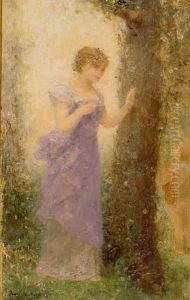Jean Ernest Aubert Paintings
Jean Ernest Aubert was a French painter born in 1824 in Vincennes, a suburb of Paris, France. His artistic journey began at a young age, influenced by the rich cultural environment of Paris and the encouragement of his family. Aubert is known for his detailed genre paintings, portraits, and mythological scenes, showcasing a blend of classical and romantic art influences that were prevalent during the 19th century.
Aubert's education in art was deeply rooted in the traditional French academic system. He studied under influential figures of his time, including Paul Delaroche, a prominent painter known for his meticulously detailed historical and mythological paintings. This mentorship played a crucial role in shaping Aubert’s style and artistic direction. As a student, Aubert honed his skills at the École des Beaux-Arts in Paris, an institution renowned for its rigorous training and emphasis on classical art principles. His time at the École des Beaux-Arts prepared him well for a career that would be celebrated by both his contemporaries and successors.
Throughout his career, Jean Ernest Aubert exhibited his works at the prestigious Paris Salon, an annual event that was the cornerstone of an artist's reputation and success in France. His paintings often depicted scenes of everyday life, imbued with a sense of realism and attention to detail that captivated viewers. Aubert's ability to convey the nuances of human emotion and the subtleties of social interaction made his works particularly appealing. His portraits, characterized by their expressive depth and technical finesse, were highly sought after by the Parisian elite, further solidifying his status as a respected artist of his time.
Aubert's work also delved into the realm of mythological themes, where he brought stories and characters from ancient mythology to life with vivid imagination and classical grace. These paintings reflected his deep appreciation for the beauty of the human form and the complexity of human emotions, themes that were central to much of his artistic output.
Jean Ernest Aubert's contribution to French art was not only in his creations but also in his influence on the generations that followed. His adherence to the principles of academic art, combined with a keen observation of the human condition, made his work a bridge between the classical traditions of the past and the evolving artistic expressions of his time. Aubert passed away in 1906, leaving behind a legacy that continues to inspire admiration and study for its beauty, craftsmanship, and humanism.





